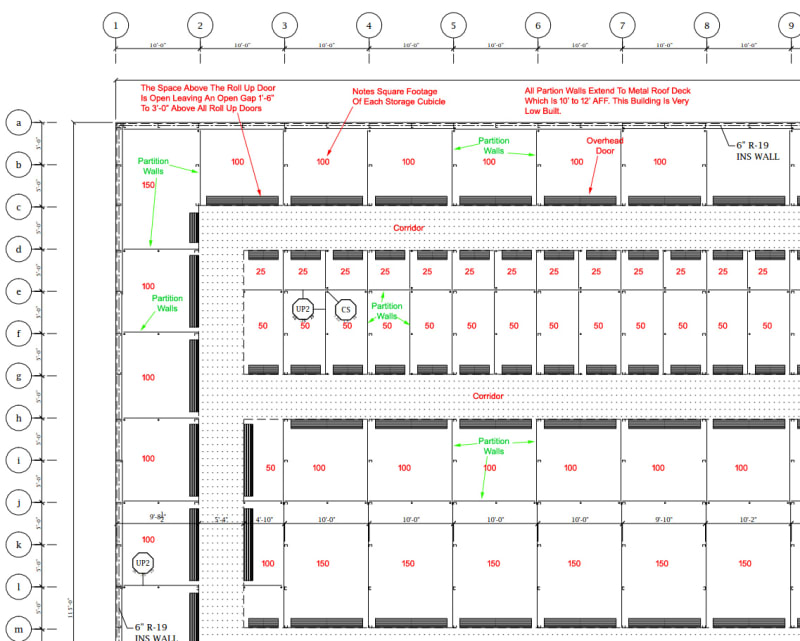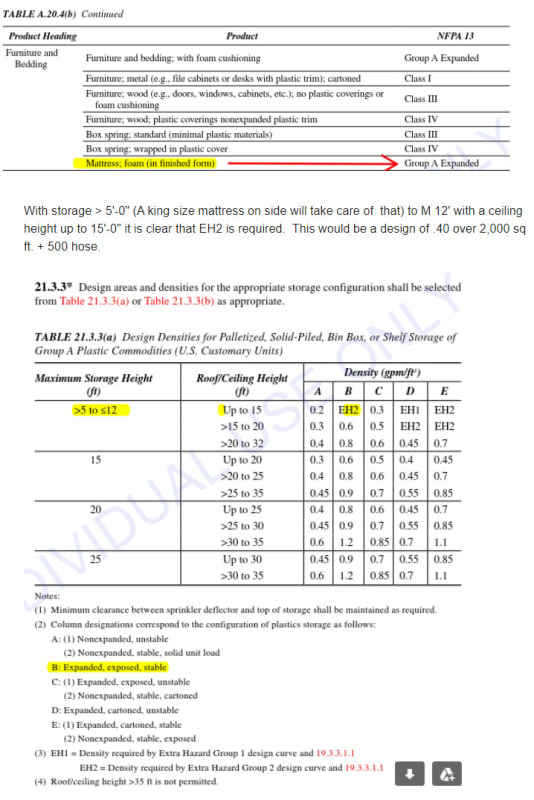SprinklerDesigner2
Mechanical
This is a small portion of the building that comes out to 30,000 sq ft.
4" bent metal purlin construction. Yes, 4" deep purlins.
The roof is 10' on low side and 14' on high side. Pitch is 1/4" in 12".
As noted all partitions extend to roof deck except for the front partition where the roll up overhead door is which has a gap. I was told the space runs between 1'-0" and 3'-0" depending where it is in the building.
I have to believe this is an Extra Hazard II Occupancy because I just have to believe it is full of mattresses and upholstered furniture. Try as I might I can not talk myself into an OH2 which would make life super simple. I just can't and won't unless some engineer wants to put that in writing which I doubt they will. Any engineer here wanna volunteer? I will make it worth your money.
My problem is spacing.

It it was all 100 sq ft cubicles life would be easy but they vary from 150 sq ft down to 25 sq ft.
I looked at standard spray sprinklers .40/2,000 and I got a mess. Luckily the water is there (good very flat curve) but I am coming up with 2,000 gpm. It's nuts.
I briefly looked at ESFR and while I would love design 12 heads the obstruction requirements care me to death and so does the minimum distance requirements.
Next I looked at CMSA Table 22.3 (NFPA 13 2019 Edition that I am still getting used to, but I can't find solid pile Exposed expanded plastic. With a max height of maybe 10' how do I classify it whether palletized or solid pile?
I wish it had racks then the CMSA would make it easy.
And on a quick draft my 30,000 sq ft bldg has 752 heads.
And for the record I feel very uneasy with self storage buildings. To many unknowns.
4" bent metal purlin construction. Yes, 4" deep purlins.
The roof is 10' on low side and 14' on high side. Pitch is 1/4" in 12".
As noted all partitions extend to roof deck except for the front partition where the roll up overhead door is which has a gap. I was told the space runs between 1'-0" and 3'-0" depending where it is in the building.
I have to believe this is an Extra Hazard II Occupancy because I just have to believe it is full of mattresses and upholstered furniture. Try as I might I can not talk myself into an OH2 which would make life super simple. I just can't and won't unless some engineer wants to put that in writing which I doubt they will. Any engineer here wanna volunteer? I will make it worth your money.
My problem is spacing.

It it was all 100 sq ft cubicles life would be easy but they vary from 150 sq ft down to 25 sq ft.
I looked at standard spray sprinklers .40/2,000 and I got a mess. Luckily the water is there (good very flat curve) but I am coming up with 2,000 gpm. It's nuts.
I briefly looked at ESFR and while I would love design 12 heads the obstruction requirements care me to death and so does the minimum distance requirements.
Next I looked at CMSA Table 22.3 (NFPA 13 2019 Edition that I am still getting used to, but I can't find solid pile Exposed expanded plastic. With a max height of maybe 10' how do I classify it whether palletized or solid pile?
I wish it had racks then the CMSA would make it easy.
And on a quick draft my 30,000 sq ft bldg has 752 heads.
And for the record I feel very uneasy with self storage buildings. To many unknowns.

